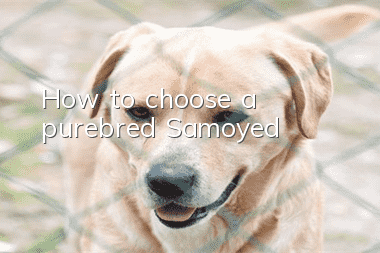How to choose a purebred Samoyed?

The Samoyed dog is very lively, alert, noble and elegant, and very lively. Working dogs originally lived in cold areas, so they have a very thick coat that can withstand various climatic conditions. Such an excellent Samoyed dog, in real life, many people also raise it. So if readers want to raise it, how should they choose it? How much does a Samoyed dog cost? Follow the editor to learn more Find out more!
How much does a Samoyed dog cost?
1. The price of purebred Samoyed puppies is about 3,500 yuan;
2. The Samoyed is slightly inferior in appearance and costs about 3,000 yuan;
3. The price of Samoyed puppies is generally 1,500-2,500 yuan;
4. The price of an adult Samoyed dog is 2,000-4,000 yuan;
How to choose a purebred Samoyed?
1. Hair volume: To determine whether a Samoyed puppy is a purebred, hair volume is very important. The heavier and thicker the coat, the better the Samoyed puppy. At the same time, the quality of the hair of Samoyed puppies is more important than the quantity of hair. The best effect is to pick it up and loosen it. The hair will immediately spread out and recover in a spray shape, which is the best indication of excellent fiber quality.
2. Coat color: The color of purebred Samoyed puppies should be pure white or white plus light yellow, cream or light yellow. Other colors are not good.
3. Skeleton: A very important factor in selecting a purebred Samoyed is the skeleton. Dogs have a big frame, so they can grow tall and beautiful in the future. Therefore, when choosing a Samoyed puppy, you should pay great attention to the dog's frame. If it cannot be seen with the naked eye, you can also touch it. Another point is to look at the paws of Samoyed puppies. The bigger the paws are, the taller they can grow in the future. Naturally, such Samoyed puppies are better.
4. Head: The mouth length of a purebred Samoyed accounts for 40% of the head. The eye sockets are apricot-shaped and darker in color. The distance between the eyes is slightly wider. The outer corners of the eyes are like the base of the ears. At the same time, the tips of the ears of purebred Samoyeds are thin and round. The ears are thick. One more thing to note: smile. A smile is the hallmark of a purebred Samoyed. That is, the corners of the Samoyed's mouth are turned up, making it look like he is smiling at any time.
5. Posture: Good purebred Samoyed puppies have very graceful shapes. So when we choose, we can look at the dog’s walking and trotting gaits. A good Samoyed puppy should have a strong, sturdy gait. It runs very easily and gracefully, and is full of agility. At the same time, the limbs of puppies should be relatively long, and the relatively developed hind legs are also one of the characteristics of Samoyed.
6. Personality: Personality testing of purebred Samoyed puppies is also very important. There are some simple methods to test the future socialization and aggression of small Samoyeds, but generally speaking, personality is determined by genetics. Of course you can also train the day after, but it will be more difficult. Simply put, Samoyed puppies that are more lively and not afraid of people will be better.
- Dog’s anal gland odor, please note that this is a sign of your dog’s health!
- How to make your dog like to eat dog food Four ways to make your dog fall in love with dog food
- How to protect your dog’s food? Teach you tips on training your dog
- Why do dogs defecate everywhere? How can dogs stop defecating everywhere?
- What should I do if my dog has lupus? Immune system diseases should not be underestimated
- If your dog's hair is cut and the skin is cut, the flesh is exposed. If the dog's hair is accidentally cut and the skin is cut, it must be disinfected immediately.
- Do dogs need deworming in summer? What should you pay attention to when raising dogs in summer?
- What to do if your dog has indigestion? Dog indigestion is no small matter!
- What should you pay attention to when vaccinating your dog? What should you pay attention to when vaccinating your dog?
- Symptoms of Rheumatism in Dogs What conditions can cause rheumatism in dogs?



